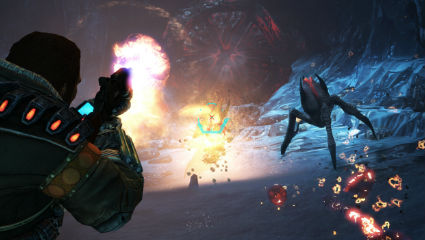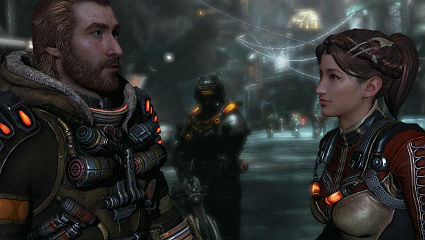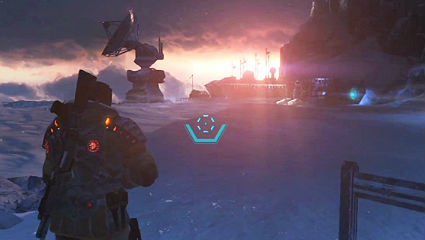Reviews
Lost Planet 3
September 19, 2013, Author: Jesper Hauerslev
Welcome to E.D.N III, where it’s cold and dangerous and where dark secrets will end you if the wildlife hasn’t torn your limb from limb first.
Working class hero
You arrive here as Jim Peyton, a hard-working family man who’s taken up a lucrative contract on E.D.N III as an engineer to help set up a mining outpost and dig for “thermal energy” (T-Eng for short). T-Eng is an alien substance that, if harnessed, could end the devastating energy crisis back on Earth. None of that matters to Jim though. He’s doing this purely for his family and the little video-messages that Jim exchanges with his wife from time to time show a loving and caring relationship, where both are trying hard to get through the humdrum of daily life with the other being so far way.
The outside world, with all its petty power struggles between global corporations and desperate politicians, matters little to the couple as they joke about taking the trash out or listen to a “mix tape” of all their favourite tunes. It’s a surprisingly gentle and touching element set in stark contrast to a harsh world that eventually starts buckling under the strain, as E.D.N III holds more than endless wastes of ice and giant monsters. There are dark and dangerous secrets here that someone wants to remain hidden no matter the cost and Jim ends up the reluctant hero, holding the future of the whole planet, and indeed mankind, in the palm of his hand.
Working class hero
While the title does say “3”, Lost Planet 3 is actually a prequel to the original Lost Planet from 2006. That means a goodbye to the lush environments of Lost Planet 2 and a return to the icy wastes of the original. The only thing that hasn’t changed are the Akrid, the local wildlife. They are just as ferocious as ever and especially the larger Akrid will take some effort to defeat. Good thing too, otherwise there wouldn’t be anything to shoot at.
Lost Planet 3 is still a shooter at heart like its predecessors, so there are plenty of opportunities to scratch that itchy trigger finger. The arsenal includes shotguns, assault rifles, hunting rifles with powerful scopes, pulse rifles and grenades. Weapons can be upgraded as you go along so they can pack a bigger punch, hold more ammo and so on. The sweetest weapon in the arsenal, however, is your rig; a huge mech. Affectionately known as Gertie, the rig comes equipped with a massive claw and drill that not only is good for punching through thick layers of ice, but also lets you tear through the Akrid in delightfully messy way.
You rig is not only a formidable weapon in its own right, it also holds unlimited ammo for your weapons and provides a safe shelter when the huge devastating ice storms of E.D.N. III rolls in to freeze everything with a pulse dead in its tracks.

Don’t expect any warm welcome from the Akrid
At the center of Jim’s adventures on E.D.N III is Coronis, the main base of operations and his home. Here you can visit the quartermaster to upgrade your weapons, head down to the hangar to upgrade your rig with better equipment or just hang out with some of your co-workers before heading back out again to fix stuff, save someone, shoot Akrid or collect T-Eng. The latter is quite important as T-Eng can be converted to cash, which is what gets you the valuable upgrades for both weapons and rig.
Upgrade you must, too, because the Akrid are tough bastards that only get stronger and more ferocious as you progress deeper into the game. In doing so, you’ll journey across open plains during raging blizzards, climb mountains to enjoy amazing views, delve deep into dark caves and sneak through derelict bases as you flick switches, turn on computers, redirect power and whatever else you do as an engineer.
So far so good, yet while none of the above is exactly broken it’s also quite run-of-the-mill. That, in a nutshell, is where Lost Planet 3 stumbles. It has a lot of good ideas but often fails to turn these into exciting gameplay.
For instance, the game spends a lot of time early on to give the illusion of freedom to roam and explore more or less as you see fit. You get acquainted with the weapons, your rig, the Akrid, how to collect T-Eng from various hotspots around Coronis and how to get there and back again. The game even encourages you to go back to these hotspots on a regular basis to collect the T-Eng. Likewise, people around Coronis will often have smaller tasks for you to get busy with in exchange for more T-Eng or special gadgets to collect upon your return.
In reality, the game-structure is near rock-solid with little to no room for you to manoeuvre. You’ll find your various missions often take you in the complete opposite direction of the areas the game is so keen for you to get to know early on. As the game progresses, you’ll find your trips back to Coronis keep getting fewer and further between. This makes the option to upgrade your weapons and rig almost obsolete, because you spend so much time away from any upgrade-vendor anyway that you learn to simply make do with what you’ve got.
Similar thing happens with the “umbilical field”, a sort of Wi-Fi-like signal which allows Jim to access the systems on his rig while on foot, so he can bring up a HUD showing his current weapon loadout and more importantly, radar. Unfortunately, the umbilical field only extends a few meters from the rig so as soon as Jim moves too far away, he loses all info.
On paper, this might have worked as something to bring tension to the mix, as Jim has to venture far way from the rig and deep into dark caves with nothing but his flashlight to guide the way and warn against enemies. The problem is that Jim spends most of the game doing exactly that, so the umbilical field becomes pretty much redundant since it is so rarely available anyway. Again; you simply learn to make do without it. On top of that, the Akrid, with very few exceptions, rarely catch you off guard. You pretty much always know when an attack is imminent so there is actually very little use for the radar to begin with.
When you finally do get to spend some time in the rig, the experience is marred by a series of inconsistencies that overshadow what is otherwise a nice feature. For instance, the game will lock you in the cockpit at certain times when you move from one location to another for no other reason then “for your own safety” as the display says. The strange thing is that this only happens in areas where absolutely nothing happens, yet it’s perfectly fine with unlocking the cockpit and letting you leave the rig in areas crawling with Akrid.
This leads to another more major annoyance; your rig is surprisingly fragile, even early on in the game. The smaller Akrids especially are annoyingly adept at quickly punching dents in your rig quickly, forcing you to get out and fight the beastly bugs on foot while the rig self-repairs. While piloting the rig, you can block incoming attacks but that seems only efficient when you are facing the enemy directly and often the Akrid attack in packs so blocking makes little difference. This downright kills the coolness of being in a huge mechanized rig fighting monsters and is just another example of something that looked good on paper: how long can you hold of the Akrid before you have to face them on foot?
The major flaw here is that the rig is so fragile and cumbersome in a fight that you are better off just attacking on foot as soon as you spot the buggers. The whole thing is made even more perplexing by the fact that the really big Akrids – the game’s equivalent of boss-battles – seem almost completely incapable of dealing any major damage to the rig. In the end you are left with what should have been a unique selling point, that shines bright the first time you get to experience it, but then fizzles out immediately after, leaving you in the dark. A quick remedy would have been to make you near invincible once in the rig. You spend so little time in the rig anyway that developers might at least have made these few minutes totally awesome as you crush and stomp your enemies into mush or grab them and drill them to bits using your claw and drill to devastating effect.

Where is your giant armored rig when you need it?
Luckily, running and gunning on foot works well. The controls are responsive and the game even sports a new cover function but yet again, this cool new feature goes mainly underused. Often, the best strategy is to simply stay moving and stay shooting. You are also equipped with a grappling hook that you can use to access ledges high above or far below. Sadly, its uses are strictly limited to navigating the levels and can’t be used during combat, at least not in any meaningful way. It would have been nice to be able to use it in combat to quickly pull yourself out of harms way or maybe even use it to scale the bigger Akrid to get a better shot at its weak spots.
Cool looks
Lost Planet 3 is powered by the Unreal Engine, yet while it does an admirable job as always, there isn’t much “wow” factor to be found here. There are a few stunning moments though, like the view from the top of a mountain as the sun rises in the distance, but overall the choice of Unreal seems a bit overkill as it’s clearly not utilized to its fullest. Either the team didn’t know how or they simply didn’t have the time.
The result is a rather bland look overall with some stiff animations. The overall aesthetic is rather nice though and the world of E.D.N III looks both believable and more or less like you would expect a frozen world to look like, but therein lies the problem. This is a world encased in ice so there is little room for variety. The game does its best by throwing in some dark underground caverns and abandoned bases, but see one and you’ve seen them all. It doesn’t really show us anything new or take us places we haven’t been before. Same goes with characters where the men wear the big and bulky survival-suits and carry the same bulkier weapons that we’ve seen them do in other games, while the women wear the same thin and very skin-tight outfits.

“Aren’t you a cold in that?”
Luckily, the Akrid benefit from some more variety. They take on various forms ranging from small but fierce bug creatures to bloodthirsty panther-like predators. and even giant ice-crabs. The artists, taking their cue from the bugs in Paul Verhoeven’s Starship Troopers, clearly had fun coming up with the designs, and they span far and wide in appearance from intimidating to even comical. Dispatching the Akrid can be a joyful mess too, especially when you do it using the rig, as orange goo flies everywhere and the creatures squirm and scream in pain as you drill giant holes in them or pull them apart limb from limb.
The sound of sci-fi
While graphics on the whole are on the bland side, there is a lot more to be said for the sound. Like with the visual design of the Akrids, Lost Planet 3 carries its inspiration for sound, and especially music, on its sleeves. James Horner’s score for Aliens has clearly been a major inspiration for Lost Planet 3 and this sets a tone of eeriness right from the start, rising and falls in intensity in perfect balance with what happens on the screen. The sound of Akrids screaming and roaring is also very fitting as are the sounds of weapons firing, winds howling, rigs moving their massive bodies around, ice crumbling, computers beeping and so on.
The voice-acting especially deserves extra credit. All characters are well-cast and Jim especially comes across as a very likeable protagonist with a perfect balanced mix of humility, sincerity, warmth and wit. He’s even got some witty one-liners, as do some of the supporting characters, and the script is even confident enough to, on occasion, break the “fourth wall” and go all meta-physical in subtle but clever ways.
Backstabbing
Lost Planet 2 was pretty much all about multiplayer mayhem while Lost Planet 3 is much more about the story with multiplayer taking a backseat. The result is a much more stripped down, but also more focused, multiplayer. Gone are most of the unique features of the previous games, replaced by more standard fare like team deathmatch and Extraction, which is an offshoot of capture-the-flag. Scenario on the other hand sees you and your team complete certain objectives. As standard as these might be, they are still good fun and it’s nice to have something other than just Akrid to shoot at.
Multiplayer also makes better use of things like the cover-function and your grappling hook, which can be used to gain higher ground during the heat of battle and thereby a better strategic position. One mode deserves special mention though and that is Akrid Survival. As the title may suggest, this mode sees you fight off wave after wave of Akrid to take over an outpost, but you do so alongside other teams of players. Later, the tables will turn and you now have to battle the opposing teams in a fight to the finish against your former allies to claim victory.
“One return-ticket, please!”
You couldn’t exactly call the first Lost Planet original but at least it did what it did well, and this at a time where third-person shooters on consoles were just finding their feet. Lost Planet 3 does what is does well too, but times are different now and it’s already a crowded space out there. Lost Planet 3 isn’t exactly struggling for breath amongst its competitors but it doesn’t dare to reach further than its grasp. This is a shame, especially since some of its ideas are actually quite good, but also because this would have been the perfect opportunity for Capcom to try something new with the series to avoid staleness setting in and, perhaps more importantly, to keep it relevant.
Lost Planet 3 doesn’t exactly do anything wrong, but it doesn’t really get everything right either. There is the illusion of freedom and choice in exploring an interesting world but it is just that: a fragile illusion. You see hints of the ideas great on paper, but the decisions made by designers are downright counter-intuitive while their implementation is bordering on amateurish.
One very good example is early on the game, where you’ve been caught in a snowstorm. Your rig is frozen solid so you have to exit and clear the ice off the joints before you can move on. As soon as you blast the last block of ice away, the storm clears and you find that your destination is actually just a few paces to your right. You don’t even need your rig to access the area in the first place, making the whole exercise utterly pointless.

E.D.N III does offer some beautiful views
Despite all this, I can’t bring myself to call Lost Planet 3 a bad game either. The action is competent enough to keep you entertained in small sittings at a time and the multiplayer, while stripped down, is good solid fun with friends. The game’s biggest achievement though is actually the overall ambience it manages to create with a compelling world, populated by believable characters and is propelled forward by an interesting premise. There is a great sense of loneliness, as you traverse the frozen expanses of this hostile environment and you feel a fully fledged member of a ragtail crew of grease monkeys working under extreme circumstances.
That gnawing feeling that not all is what it seems on E.D.N III keeps creeping ever closer and creates a great sense of uneasiness as you play. This is a good thing and this works very well in conjunction with the harsh and extreme environment and the fact that you so far away from everything.
In the end, if you were a fan of the action of the originals, you might find this trip to E.D.N III a little less appealing. If you are fascinated by the lore of the Lost Planet universe or are simply looking for an accessible shooter and can overlook various shortcomings, then Lost Planet 3 is not a bad visit to make. Just make sure you get a return ticket.
Platforms: PC, PS3, Xbox 360 | Tagged akrid, Aliens, edn 3, lost planet, lost planet 2, mech, Rig, starship troopers



